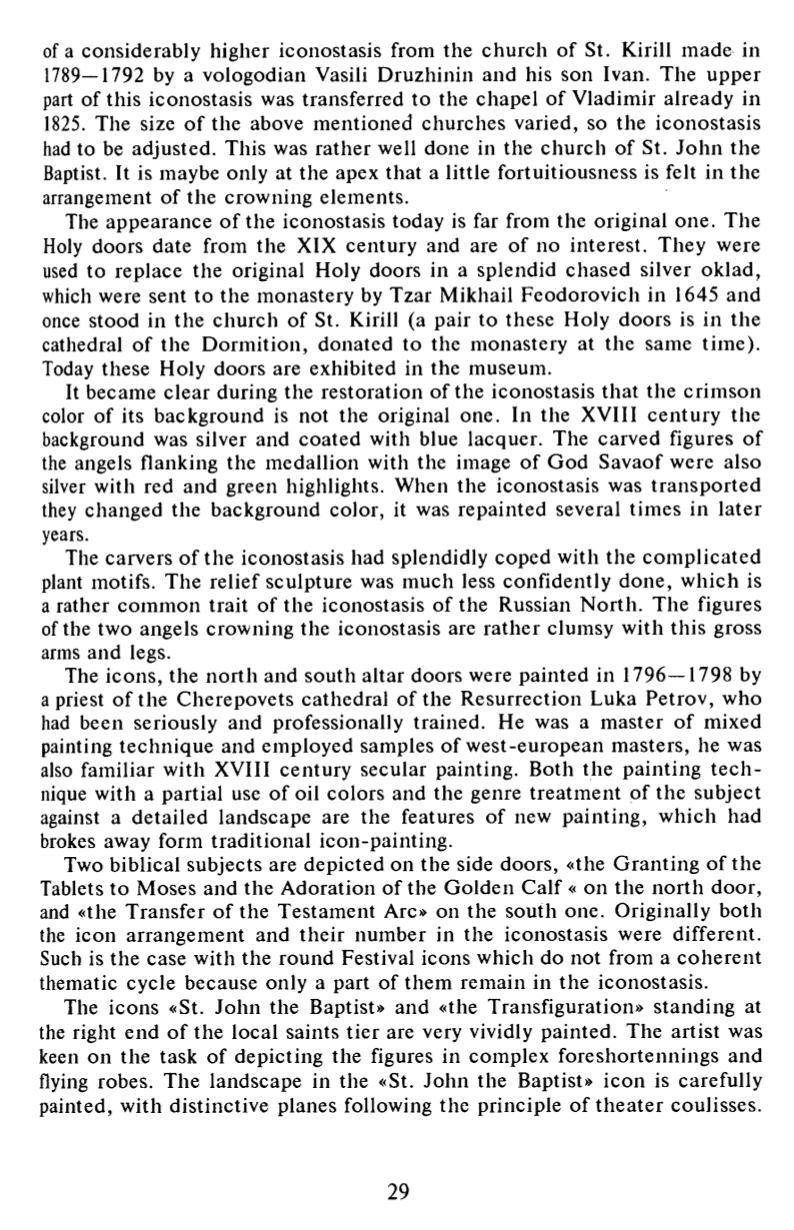

of a considerably higher iconostasis from the chu rch of St. Kirill made in
1789—1792 by a vologodian Vasili Druzhinin and his son Ivan. The upper
part of this iconostasis was transferred to the chapel of Vladimir already in
1825. The size o f the above mentioned churches varied, so the iconostasis
had to be adjusted. This was rather well done in the church of St. John the
Baptist. It is maybe only at the apex that a little fortuitiousness is felt in the
arrangement of the crowning elements.
The appearance o f the iconostasis today is far from the original one. The
Holy doors date from the XIX century and are o f no interest. They were
used to replace the original Holy doors in a splendid chased silver oklad,
which were sent to the monastery by Tzar Mikhail Feodorovich in 1645 and
once stood in the church of St. Kirill (a pair to these Holy doors is in the
cathedral o f the Dormition , donated to the monastery at the same time).
Today these Holy doors are exhibited in the museum.
It became clear during the restoration of the iconostasis that the crimson
color of its background is not the original one. In the XVIII cen tu ry the
background was silver and coated with blue lacquer. The carved figures of
the angels flanking the medallion with the image o f God Savaof were also
silver with red and green highlights. When the iconostasis was transpo rted
they changed the background color, it was repainted several times in later
years.
The carvers o f the iconostasis had splendidly coped with the comp lica ted
plant motifs. The relief sculpture was much less confidently done, wh ich is
a rather common trait of the iconostasis of the Russian No rth . The figures
of the two angels crowning the iconostasis are rather clumsy with this gross
arms and legs.
The icons, the no rth and south altar doors were painted in 1796—1798 by
a priest o f the Cherepovets cathedral of the Resurrection Luka Petrov, who
had been seriously and professionally trained. He was a master o f mixed
painting techn ique and employed samples o f west-european masters, he was
also familiar with XVIII century secular painting. Both the painting t e c h
nique with a partial use o f oil colors and the genre treatmen t of the subject
against a detailed landscape are the features of new painting, which had
brokes away form traditional icon-painting.
Two biblical subjects are depicted on the side doors, «the Gran ting o f the
Tablets to Moses and the Adoration of the Golden Calf « on the no rth door,
and «the Transfer o f the Testament Arc» on the south one. Originally both
the icon arrangement and their number in the iconostasis were different.
Such is the case with the round Festival icons which do not from a cohe ren t
thematic cycle because only a part of them remain in the iconostasis.
The icons «St. John the Baptist» and «the Transfiguration» standing at
the right end o f the local saints tier are very vividly painted. The artist was
keen on the task of depicting the figures in complex foreshortennings and
flying robes. The landscape in the «St. John the Baptist» icon is carefully
painted, with distinctive planes following the principle o f thea te r coulisses.
29















